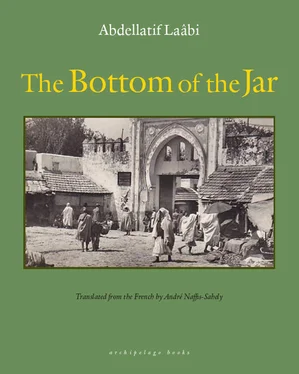But things weren’t going so well for Namouss. Driss didn’t even want to hear about firecrackers, the sole object of Namouss’s desire since he wasn’t any good at the other games, which he limited himself to watching or on occasion to acting as a referee, a lackluster role in these circumstances. He was only able to get enough money from Driss to buy a whirligig. While he was at it, he decided to satisfy an old craving, since, when it came to whirligigs, Namouss wasn’t taken by the European varieties found in shops. Those factory-made whirligigs usually broke on first impact and their colors faded quickly. He preferred instead the handmade ones built by local artisans whom Namouss loved to watch while they worked.
The woodturner’s shop was located right at the end of Namouss’s street. The woodturner was always hard at work, with such. . how to put it. . loving devotion that nothing could distract him. Even when clients turned up with orders, they knew they would have to wait for the master craftsman to finish working on the piece he had in his hands. If the customer in question was a child, the wait became even longer. The craftsman had more important priorities, and when he eventually turned his attention to his young customer, it was more out of kindness than anything else, since making a whirligig wasn’t such a big deal. He would then take a piece of shapeless wood, sand it down, keep it in place with his toe, and start to chip away at it. The way he used his tools made him look like a violinist. His chisel flew through the air like a bow and — presto! — the whirligig began to take shape. The only thing left to do was to equip it with an iron tip. But that was not the woodturner’s job. For that, the child would have to go a stone’s throw away to the blacksmith in the El-Haddadine souk.
Total change of scene. Having accomplished the most pleasant part of his quest, Namouss was frightened by this next part. But he had no choice. The blacksmith’s forge was shrouded in darkness. The flames of the furnace barely lit the blackened faces of the master and the apprentice, who was blowing air into the fire with a bellow. The smell of burning was unbearable. The eyes of the blacksmith shone with a strange sparkle, and the smile out of the corner of his mouth froze Namouss with fear. All’s well that ends well. The iron tip was ready and it was then attached to the bottom of the whirligig, allowing Namouss to flee that dangerous situation.
Back out into the open air. Though he had his whirligig in his pocket, he didn’t feel like playing. The trip to Sidi Harazem had inspired new feelings in him. That first voyage had filled him with a sense of pride. Many of the neighborhood children he played with had never lived what he considered a great adventure. That shift in time and space had opened a window onto the future, there, in a place where he had seen himself equipped with wings, flying above the city of Fez, embracing horizons both known and unknown. All of a sudden — and perhaps because he has just evaded a great peril — the desire to rediscover his town took hold of him. To rediscover it with eyes that had gone traveling, with the need to commit to memory what was at risk of being lost, if ever he should acquire those wings, which would whisk him so high and far away to the point of no return. Right up until that moment, he had lived inside the Medina as if it had been a cocoon. He had never before asked himself how that cocoon had come to be and who had made it. A pupa among pupae, he waited with a vague sense of consciousness for the moment when he might break through the soft pod and step out into the light.
And this is where the journey begins.

NAMOUSS’S STOMPING GROUND was the size of a handkerchief. He kept within the bounds of the Qarawiyyin neighborhood, if that. As for the other neighborhood, that of the Andalusians, Namouss had never, in a manner of speaking, set foot in it. For him, as for most of his friends, it was almost a foreign country, where one should never venture. Hostile children lived in those parts, with whom they never crossed paths aside from the occasional scuffle. When those took place, the battles were regulated by strict rules of engagement. An emissary was dispatched to the enemy camp to deliver the declaration of war, to put forward a date for the commencement of hostilities, as well as to agree on the weapons that were to be used — usually belts and/or stones — not to mention techniques of impromptu hand-to-hand combat, where direct blows to the head were deemed dangerous and only permitted under certain circumstances. The neighborhood’s self-proclaimed Joint Chiefs of Staff then set to planning their strategy and commenced their recruitment drive. Barely a flyweight, Namouss was not among the children called up for duty. Even though he was entrusted with some small tasks, when the hostilities began he’d had to content himself with watching from the sidelines.
Admittedly, he felt comfortable with this role. Was it a case of cowardice or rather a precocious adherence to the tenets of nonviolence? The question remains unresolved. In any event, those wars did not leave a significant mark on him. By the time he would remember a battle was due to take place in his neighborhood, it would already be over, the dust settling — according the “official” version of the events — in triumph over the foreign invaders. Victories aside, what Namouss had learned was that he should not cross into enemy territory on his own. His neighborhood was enough for him, since it was after all the most prestigious one, home to both of the city’s leading mosques — the Qarawiyyin and the Moulay Idriss — and was also the liveliest, since the business activity of the city was concentrated there. Namouss knew his neighborhood souk by souk, square by square, street by street. He knew all the shortcuts to take through its alleys. More important, he knew how and when to meet the unusual characters that so fascinated him. Who were they? Angels or demons? Beggars or prophets? Who knows. Both the settings they were in and the way they spoke stood in sharp contrast to how demure most people usually were. The adults didn’t hold them in high esteem. They would stop and listen with half-amused, half-reproachful looks on their faces and then continue on without a word. The children, however, were torn between a vague sort of admiration and an instinctive hostility against those poor outcasts. As for Namouss, he was pulled in by their eccentricity; they reminded him of his uncle Touissa. The words that came out of their mouths had the same effect on him as his uncle’s stories. Through them, he discovered that words could be used in unconventional ways. Not unlike his first day of school, when Mr. Benaïssa had begun to play his flute, Namouss understood that there were words and words , music and music .
Speaking of words and music, the first character that took his place in Namouss’s pantheon was a rather gentle, taciturn man, and a regular feature in the Spring of Horses: Mikou. It was said he was a scion of a large family, which he had left behind in favor of a free, wandering lifestyle that had in turn led to his family disowning him. As a result, many homes opened their doors to him, where, depending on their mood, Mikou would be able to eat and sleep in exchange for a few chores: taking the bread to the oven, filling buckets of water at the public fountain, carrying heavy packages, or assisting with the spring cleaning. Somewhat simpleminded, Mikou had a glowing face and was particularly popular among the children, who occasionally paid him court throughout the course of his peregrinations. Mikou would then perk up and, surrounded by a small crowd of his followers, would use his beautiful voice to intone one of his own compositions:
Читать дальше













